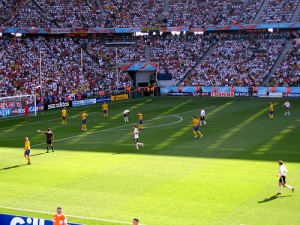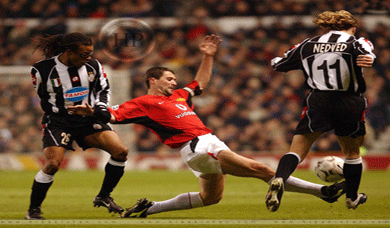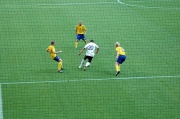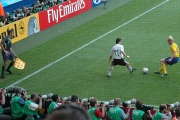|
 |
|
 |
 |
|
|
Football
Association football, more commonly known as football or soccer, is a team sport played between two teams of eleven players using a spherical ball. Association football is the most popular football variant worldwide, and is widely considered to be the most popular sport in the world.
 |
The game is played on a rectangular grass or artificial turf field, with a goal in the centre of each of the short ends. The object of the game is to score by driving the ball into the opposing goal. In general play, the goalkeepers are the only players allowed to use their hands or arms to propel the ball; the rest of the team usually use their feet to kick the ball into position, occasionally using their torso or head to intercept a ball in midair. The team that scores the most goals by the end of the match wins. If the score is tied at the end of the game, either a draw is declared or the game goes into extra time and/or a penalty shootout, depending on the format of the competition.
The modern game was codified in England following the formation of The Football Association, whose 1863 Laws of the Game created the foundations for the way the sport is played today. Football is governed internationally by the Fédération Internationale de Football Association (International Federation of Association Football), commonly known by the acronym FIFA. The most prestigious international football competition is the FIFA World Cup, held every four years. This event, the most widely viewed in the world, boasts an audience twice that of the Summer Olympic Games.
|
| |
Games revolving around the kicking of a ball have been played in many countries throughout history. [11] Various forms of football were played in medieval Europe, though rules varied greatly by both period and location.
The modern rules of football are based on the mid-19th century efforts to standardise the widely varying forms of football played at the public schools of England.
 |
During the 1850s, many clubs unconnected to schools or universities were formed throughout the English-speaking world, to play various forms of football. Other English rugby football clubs followed this lead and did not join the FA, or subsequently left the FA and instead in 1871 formed the Rugby Football Union. The Sheffield FA played by its own rules until the 1870s with the FA absorbing some of its rules until there was little difference between the games.
The Board was formed in 1886 after a meeting in Manchester of The Football Association, the Scottish Football Association, the Football Association of Wales, and the Irish Football Association. The Fédération Internationale de Football Association (FIFA), the international football body, was formed in Paris in 1904 and declared that they would adhere to Laws of the Game of the Football Association. The growing popularity of the international game led to the admittance of FIFA representatives to the International Football Association Board in 1913. Today, football is played at a professional level all over the world.
|
There are seventeen Rules in the official Rules of the Game. The same Rules are designed to apply to all levels of football, although certain modifications for groups such as juniors, seniors, women and the physically challenged are permitted. The Rules are often framed in broad terms, which allow flexibility in their application depending on the nature of the game. In addition to the seventeen Rules, numerous IFAB decisions and other directives contribute to the regulation of football. The Rules of the Game are published by FIFA, but are maintained by the International Football Association Board, not FIFA itself.[23] The most complex of the Rules is offside. The offside law limits the ability of attacking players to remain forward (i.e. closer to the opponent's goal line) of the ball, the second-to-last defending player (which can include the goalkeeper), and the half-way line
- Two teams of eleven try to guide a soccer ball into goal cages at opposite ends of the field, using different parts of their body.
- Only the goalkeeper may use his/her hands.
- When a penalty is committed inside the eighteen-yard-line, the opposite team is granted a penalty kick.
- A direct kick is when a team gets a penalty shot on goal and no other player has to touch it before a goal may be scored
- An indirect kick is the same as a direct kick, but another player must touch the ball before a goal may be scored.
- When a player on a team kicks the ball out of bounds, a player on the opposite team throws the ball in bounds by an overhead, two-handed throw.
- Shoulder - to- shoulder contact is allowed.
|
While the premise of football seems simple--to kick the ball into the opposing team's goal--the strategies are endless. Only by understanding the complexities of the game can you truly appreciate a good match. Here's how to enhance your understanding of this beautiful game.
Steps
1.Pay attention to the diagonal runs behind the defense. A center forward making an angled run just behind another defender, say a 10 yard sprint, at just the right moment, could be getting ready to receive the ball. Is the opposition playing zone-defense and passing the offensive player to another defender? Is the player making the pass under pressure?
2. Look for how a third man running opens up the game. A midfielder and forward might exchange a few passes on the side and then a defender (a third player) will break towards the goal from behind to receive the ball – almost out of nowhere.
3. Watch how quick give-and-goes, both static and moving, open up the defense. A player can play a wall-pass (a give and go) just to get more time on the ball if he’s being closed down (static), or can play the ball and then sprint into the space to receive the ball. Keeping the ball moving relieves pressure and opens up space. Quick passes (the ball moves much faster than anyone else) breaks down a defense.
4. Keeping them busy
 |
Discover how switching the field of play gives players more time and space. Two or three passes on one side of the field and suddenly there’s no space, the defense has closed the offensive team down, and that’s when they look for a long switch to the defender or midfielder on the other side. In soccer terms it's called, ‘short short long’ or 'switching play' – a few short passes and then a long pass. At times, this switch, when done cleverly, can surprise the other team, who is preoccupied on one side, and results in a chance for a goal or a cross.
5. Learn how counter attacks can lead to goal scoring opportunities. A team may just hunker down and pack their players into their goal box and leave one player up high, waiting to break down the field when they win possession.
6. Come to embrace the long ball in soccer. Don’t knock the long ball (no pun intended). Watch how a team might pick out their forward with a long ball. The forward will control the ball and enable the rest of his team to move up the field. Or, one long pass can lead to a perfect lay off or flick to an on rushing player for a goal.
7.Observe how 'overlaps' create opportunities for crosses. A wide defender might make a run around the outside midfielder, who has cut inside, and join the attack. An effective cross creates a goal scoring chance.
8. Watch how a 'take over' (when players interchange positions) opens up space or a time and a window of space for a shot or pass. One player might dribble right at another player and exchange the ball, the other player screening the defender for a moment.
 |
9. Savor the blind pass. Look for a subtle back heel to an unseen player, looking in one direction but playing the ball the other, dribbling to the right but serving a long diagonal pass to the left side (you know that player is there). Watch for that one more pass that almost doesn't seem necessary but results in a tap in goal.
|
| Year |
Host Nation(s) |
Final |
Third Place Match |
| Winner |
Score |
Runner-up |
3rd Place |
Score |
4th Place |
1958
|
Sweden |
Brazil |
5–2 |
Sweden |
France |
6–3 |
West Germany |
1962
|
Chile |
Brazil |
3–1 |
Czechoslovakia |
Chile |
1–0 |
Yugoslavia |
1966
|
England |
England |
4–2 aet |
West Germany |
Portugal |
2–1 |
USSR |
1970
|
Mexico |
Brazil |
4–1 |
Italy |
West Germany |
1–0 |
Uruguay |
1974
|
West Germany |
West Germany |
2–1 |
Netherlands |
Poland |
1–0 |
Brazil |
1978
|
Argentina |
Argentina |
3–1 aet |
Netherlands |
Brazil |
2–1 |
Italy |
1982
|
Spain |
Italy |
3–1 |
West Germany |
Poland |
3–2 |
France |
1986
|
Mexico |
Argentina |
3–2 |
West Germany |
France |
4–2 aet |
Belgium |
1990
|
Italy |
West Germany |
1–0 |
Argentina |
Italy |
2–1 |
England |
1994
|
USA |
Brazil |
0–0 aet
(3–2) pen |
Italy |
Sweden |
4–0 |
Bulgaria |
1998
|
France |
France |
3–0 |
Brazil |
Croatia |
2–1 |
Netherlands |
2002
|
South Korea
& Japan |
Brazil |
2–0 |
Germany |
Turkey |
3–2 |
Korea Republic |
2006
|
Germany |
Italy |
1–1 aet
(5–3) pen |
France |
Germany |
3–1 |
Portugal |
|
- It is accepted that soccer started in the Britain.
- Sheffield FC is recognized as the oldest club in all over world that was established
in the year 1857.
- It is projected that this game is the most watched and most played in various parts of the world.
- Practically, soccer is known as football in most of countries excluding America, who describe it as soccer or ‘Grid Iron Football’.
- Well-known soccer competitions are the Manchester derby, Milan derby, Scotland, Real vs Barcelona, London derbies and many more.
- Maradonna, Eusebio, Dalglish, Beckham, Pele, Mattheus, Ronaldo, Charlton and Cruyff are well known players of soccer.
- It is indeed true that there were 199,854 spectators present for match – Uruguay vs. Brazil in 1950 at the Maracana Municipal Stadium.
- There were 5,098 soccer teams in the biggest soccer tournament in 1999 for Seven-a-Side Competition.
- It is fact that 16 goals scored by participant in a single soccer match- Stephan Stanis from France playing in the year 1942 for Racing Club de Lens.
- FIFA (Federation International Football Association) is recognized as the international leading organization of soccer and is located in Switzerland.
- At sixteen-year-old Diego Maradona accomplished his appearance in Soccer for Argentina.
- WUSA (Women’s United Soccer Association) made and won its first presentation in the year 2001.
- Goalies of Soccer did not have to put on colored clothes from their teammates until 1913
|
|
|
|
|
|
|

|
|
